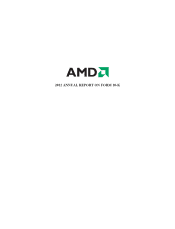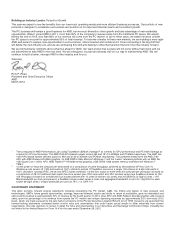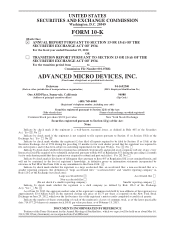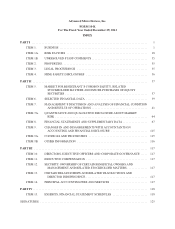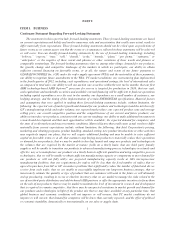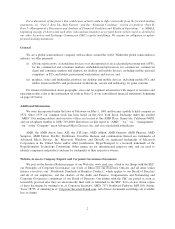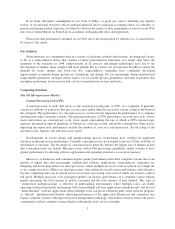AMD 2012 Annual Report Download - page 11
Download and view the complete annual report
Please find page 11 of the 2012 AMD annual report below. You can navigate through the pages in the report by either clicking on the pages listed below, or by using the keyword search tool below to find specific information within the annual report.If we make substantive amendments to our Code of Ethics, or grant any waiver, including any implicit
waiver, to our principal executive officer, principal financial officer, principal accounting officer or controller, or
persons performing similar functions, we intend to disclose the nature of such amendment or waiver on our Web
site or in a Current Report on Form 8-K in accordance with applicable rules and regulations.
Please note that information contained on our Web site is not incorporated by reference in, or considered to
be a part of, this report.
Our Industry
Semiconductors are components used in a variety of electronic products and systems. An integrated circuit,
or IC, is a semiconductor device that consists of many interconnected transistors on a single chip. Since the
invention of the transistor in 1948, improvements in IC process and design technologies have led to the
development of smaller, more complex and more reliable ICs at a lower cost per function. In order to satisfy the
demand for faster, smaller and lower-cost ICs, semiconductor companies have continually developed
improvements in manufacturing and process technology and design. ICs are increasingly being manufactured
using smaller geometries on larger silicon wafers. Use of smaller process geometries can result in products that
are higher performing, use less power and cost less to manufacture on a per unit basis.
Computing Solutions
The x86 Microprocessor Market
Central Processing Unit (CPU)
A microprocessor is an IC that serves as the central processing unit, or CPU, of a computer. It generally
consists of millions of transistors that process data and control other devices in the system, acting as the brain of
the computer. The performance of a microprocessor is a critical factor impacting the performance of a computer
and numerous other electronic systems. The principal indicators of CPU performance are work-per-cycle, or how
many instructions are executed per cycle, clock speed, representing the rate at which a CPUs internal logic
operates, measured in units of gigahertz, or billions of cycles per second, and power consumption. Other factors
impacting microprocessor performance include the number of cores in a microprocessor, the bit rating of the
microprocessor, memory size and data access speed.
Developments in circuit design and manufacturing process technologies have resulted in significant
advances in microprocessor performance. Currently, microprocessors are designed to process 32 bits or 64 bits of
information at one time. The bit rating of a microprocessor generally denotes the largest size of numerical data
that a microprocessor can handle. Microprocessors with 64-bit processing capabilities enable systems to have
greater performance by allowing software applications and operating systems to access more memory.
Moreover, as businesses and consumers require greater performance from their computer systems due to the
growth of digital data and increasingly sophisticated software applications, semiconductor companies are
designing and developing multi-core microprocessors, where multiple processor cores are placed on a single die
or in a single processor. Multi-core microprocessors offer enhanced overall system performance and efficiency
because computing tasks can be spread across two or more processing cores each of which can execute a task at
full speed. Multiple processor cores packaged together can increase performance of a computer system without
greatly increasing the total amount of power consumed and the total amount of heat emitted. This type of
“symmetrical multiprocessing” is effective in multi-tasking environments where multiple cores can enable
operating systems to prioritize and manage tasks from multiple software applications simultaneously and also for
“multi-threaded” software applications where multiple cores can process different parts of the software program,
or “threads,” simultaneously thereby enhancing performance of the application. Businesses and consumers also
require computer systems with improved power management technology, which allows them to reduce the power
consumption of their computer systems thereby reducing the total cost of ownership.
3

